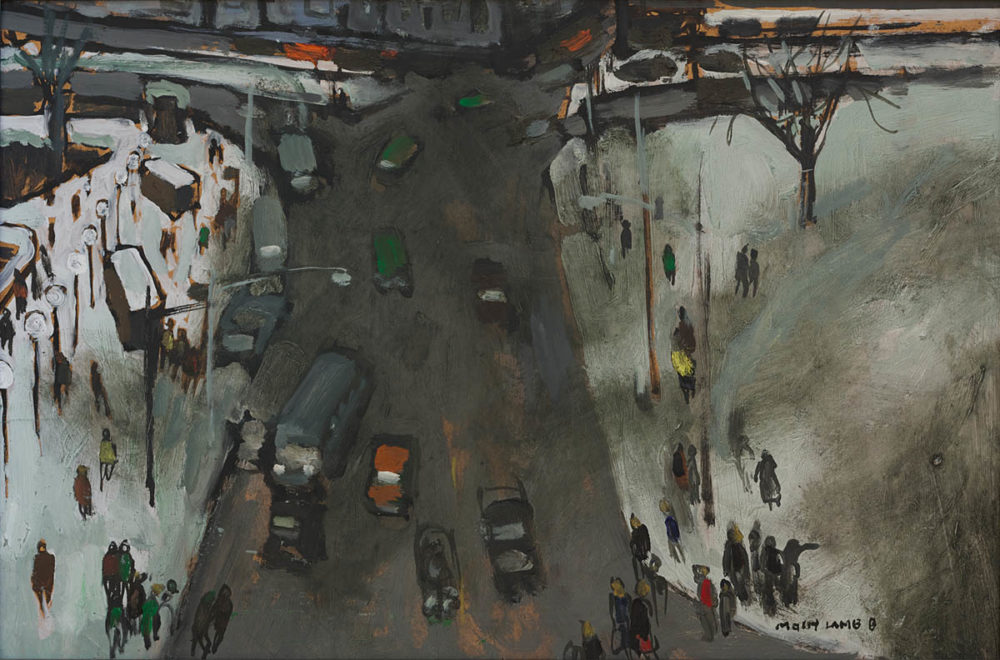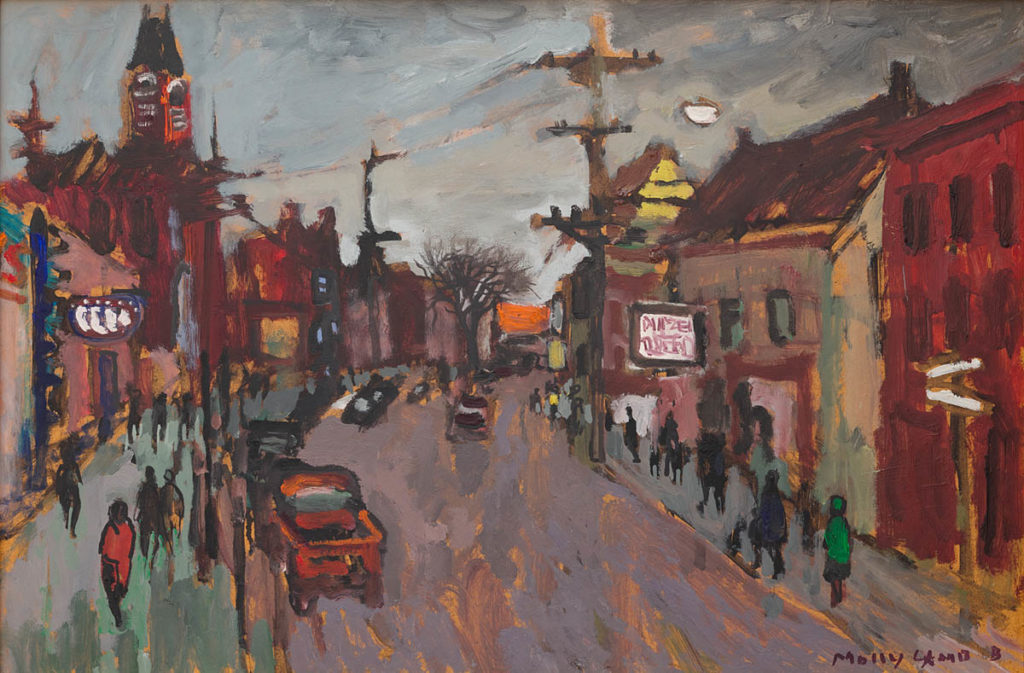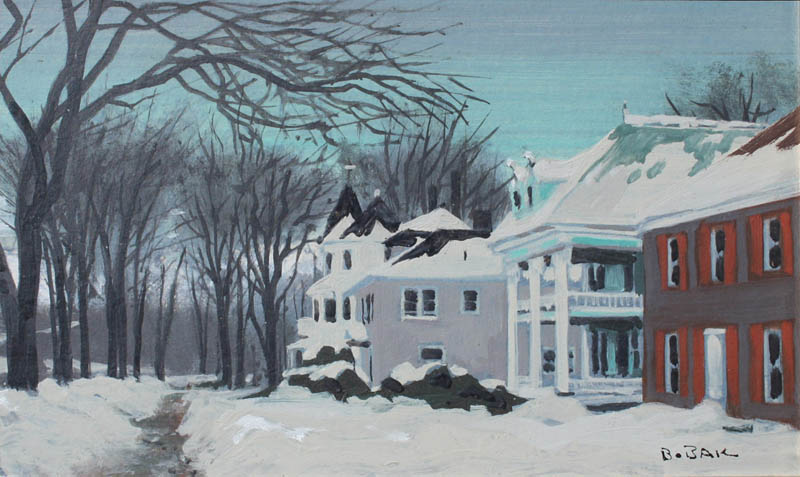A selection of works by Bruno Bobak and Molly Lamb Bobak are on display at Gallery 78 until June 10.

c. 1973, oil on board, 16 x 24 in. framed dimension: 20 x 27.5 in.
Gallery 78’s current exhibition, People and Places of New Brunswick, features a collection of work by nationally known Canadian painters Bruno Bobak and Molly Lamb Bobak. This non-selling retrospective exhibit brings together pieces from private collections that together celebrate the natural beauty, events and people of New Brunswick.
Molly Lamb Bobak

c. 1968 oil on board, 16 x 24 in. framed dimension: 23.5 x 31.5 in.
Born on Lulu Island outside Vancouver, Molly Lamb Bobak’s career as an artist was launched during World War II as an official war artist, the first woman to be given that title. Posted around the country and then overseas, she recorded the day-to-day, ordinary activities of the Canadian Women’s Army Corps. Before arriving in Fredericton in 1960 with Bruno Bobak, named resident artist at UNB, Molly had reached maturity as an artist with national and international exposure. She was of the first generation of women artists to make their way as professionals in the Canadian art world.
Since 1960, Fredericton has been home, centre for her art-making and influences as teacher, as well as subject for her paintings.
Watercolor is the medium she favored for her flowers which attracted her for their random beauty. She expressed their fragility and fleeting moments of colour and pattern with simplicity of line and washes of color blotted and splattered over white paper. Oils on canvas, on the other hand, were solid surfaces and most likely chronicle impressions of gatherings of people around one or another communal event. Joyous in flavour and riotous in colour, texture, and movement, these crowd scenes were the artist’s perceptions and responses to her immediate surroundings. They captured the essence of the occasion, rather than its details. Over the years, they have imaged skaters on the St. John River; action on the UNB football field; parades and processions; lighting of the communal Christmas tree; sunbathers on the beach; and such landmark events as the raising of the cross on the restored copper spire of Christ Church Cathedral. Even in the more restrained and solitary themes like interiors, the artist’s perspective was human-scaled, enlivened, never static.
Yet the seemingly effortless calligraphy of her watercolors or the quick-silver brushstrokes of her oils are the dressing on a structured armature. The artist, as teacher, often spoke of the ‘language of painting’ and the ‘architecture of a composition’ – the significance of form in painting (apart from subject) as key lessons learned from her teacher and mentor Jack Shadbolt at the Vancouver School of Art. Disciplined and continually committed to her art, she set an example and offered encouragement and support to many aspiring artists. In fact, her influence spawned an identifiable ‘ school of Molly Bobak ‘ in the work of many admirers.
Molly Lamb Bobak died on March 1, 2014, having just celebrated her 94th birthday.
Bruno Bobak

Aged 20 and just out of art studies at Central Technical School in Toronto, Bruno Bobak made an impressive debut as a professional artist. Having enlisted in the army, he submitted a watercolour to an army art exhibition, won first prize, and was appointed as an official war artist in 1943. From then on he was included in important exhibitions and galleries in Canada, the United States and abroad with opportunity to travel, explore, and broaden his creative experiences. It was during one such study trip to Europe that news arrived of his appointment as artist-in-residence at the University of New Brunswick in 1960. It was to be only a one-year stay in Fredericton, but it turned out to be a lifetime. From 1962 until his retirement in 1987, Bruno Bobak was director of the UNB Art Centre.
In Fredericton, in the 60s, from his studio on the campus of the university, Bruno Bobak produced some of his most vital figurative work – large canvases of life-size figures aggressively yet tenderly depicted in a dripping mix of paints, jarring colors and great sweeping gestures of expressionism. Within the relative isolation of New Brunswick, Bobak found himself in an environment and setting which afforded him the mental space and physical opportunity to do and say what he needed in his art. It culminated in a major touring exhibition, Bruno Bobak’s “Humanism”, which toured the Atlantic region in 1971.
But Bruno Bobak’s art was never limited nor confined to a single subject, medium, technique, style or vision. A consummate craftsman, he was equally adept at drawing, watercolors, printmaking, oil painting, mural-making and sculpture. With ingenuity and imagination he also designed and planted vegetable and flower gardens, reinvented uses for discarded industrial materials, designed and decorated his house, and fashioned his own furniture. Such diversification reflected his strong background in design at Central Tech. In the ’50s he would head the design department at the Vancouver School of Art. Subjects for art-making also varied: landscapes, figures, portraits, still-life, flowers, vegetables, street scenes, harbours, and buildings. Interestingly, in terms of style, in the last 25 years of his life, Bobak returned to the stark realist style of his early years. Textures became smooth and flattened, colors patterned, the palette heightened in tone, and the structure of compositions more consciously designed and ordered.
Bobak won numerous awards and prizes, among them a Canada Council Senior Fellowship and the Queen Elizabeth Medal; the 1954 Jessie Dow Prize, Montreal Museum of Fine Arts; the 1955 C.W. Jeffreys Award, Canadian Society of Graphic Art; Honorable Mention “First Exhibition of Drawing and Prints”, Lugano, Switzerland; the K.B. Baker Memorial Purchase Award “Forty-First Annual Exhibition of North West Artists”, Seattle, Washington; the 1957 Prize, Monsanto Art Competition, Montreal; Royal Society Canadian Government Overseas Fellowship. In 1982 his painting “Campus Gates” was chosen for a Canada Post stamp, representing New Brunswick in a block of 12 stamps of all the provinces and territories. In 1998 Canada Post featured a work by Bobak for it’s 90-cent stamp in the “Masterpieces of Canadian Art” series. He designed the New Brunswick Bicentennial Medal in 1984, and in 1985 was commissioned by Parks Canada to create an original multiple of a New Brunswick scene (Martello Tower) for presentation to the Governor General Madame Jeanne Sauve. The artist was presented with an honorary degree (LLD) from Saint Thomas University in 1984, and was awarded a DLit from UNB in 1986. In the autumn of 1995 he received the Order of Canada for his unique and lasting contributions to Canadian Art and for fostering artistic and cultural life in New Brunswick and Canada.
Bobak’s work is part of major public gallery collections across Canada, among them the National Gallery of Canada, the Candian War Museum, the National Portrait Gallery, the Art Gallery of Ontario, the Vancouver Art Gallery, and in Fredericton, the Beaverbrook Art Gallery, the University of New Brunswick, and the Provincial Art Bank. His paintings are included in countless prestigious corporate and private collections. His work is very well documented in numerous publications, including “Bruno Bobak: The Full Palette”, published in 2006 by Goose Lane Editions and the Beaverbrook Art Gallery.
Artists bios c/o of Gallery 78.




